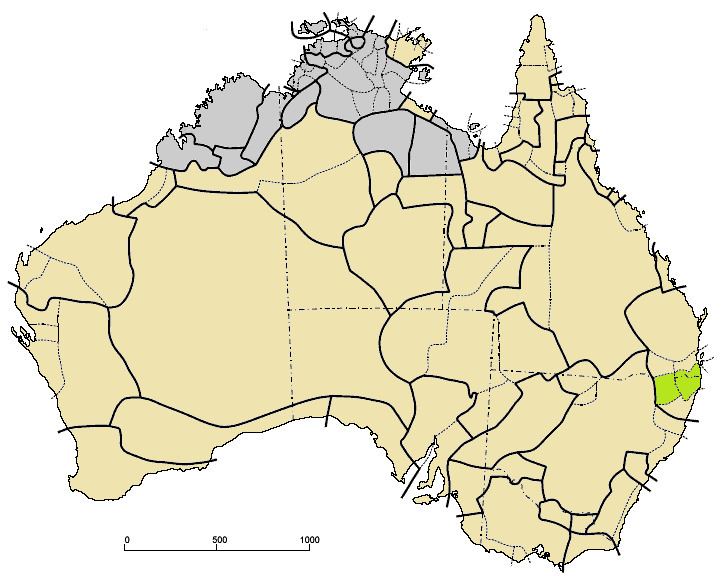Writing system Latin | ||
 | ||
Region New South Wales, Australia Ethnicity Bundjalung people, Githabul, etc. Native speakers 20 (2005) to 95 (2006 census) Language family Pama–Nyungan
Southeast
New South Wales
Durubal–Bandjalang
Bundjalung Dialects Bandjalang
Yugumbir
Nganduwal
Minjangbal
Njangbal
Biriin
Baryulgil
Waalubal
Dinggabal
Wiyabal
Gidabal
Galibal
Wudjeebal | ||
Bundjalung, or Yugambeh-Bundjalung, is an Australian Indigenous language of the northeastern New South Wales and South-East Queensland coast.
Contents
Bundjalung consists of a number of dialects, including Yugumbir (sometimes confused with Yugambal), Nganduwal, Minjangbal, Njangbal, Biriin, Baryulgil, Waalubal, Dinggabal, Wiyabal, Gidabal, Galibal, and Wudjeebal. Bowern (2011) lists Yugambal, Githabul, Minjungbal, Ngara:ngwal, and Bandjalang as separate Bandjalangic languages.
Vowels
Varieties of Bundjalung may have a vowel system of either 3 or 4 vowels that also contrast in length, resulting in either 6 or 8 phonemic vowels in total.
In practical orthography and some descriptions of the language, the letter "h" is often used after the vowel to indicate a long vowel.
Vowel Alternations
/a/ and /e/ are neutralised as [ɛ] before /j/.
The low central vowel /a/ can be fronted and raised following a palatal consonant, and backed following a velar consonant.
Unstressed short vowels can be reduced to the neutral central vowel schwa in a similar way to English.
Consonants
Bundjalung has a smaller inventory of consonant phonemes than is typical of most Australian languages, having only four contrastive places of articulation and only one lateral and one rhotic phoneme.
Obstruents
Although the standard IPA symbols used in transcription of the language are the voiced stop symbols, these segments are better characterised as obstruents because they are realised more often as fricatives or affricates than actual stops. There is no contrast in Bundjalung between these manners of articulation.
Bundjalung varieties do not have voicing contrasts for their obstruent sequences, and so phonological literature varies in its representation of these consonants- some linguists have chosen the symbols /p/, /k/, /c/, /t/, and others have decided upon /b/, /g/, /ɟ/, /d/. Generally, these consonants are phonetically voiceless, except when following a homorganic nasal segment.
Nasals
When nasal stops occur syllable-finally, they are often produced with a stop onset as a free variant.
Lateral
The lateral phoneme can appear as a flap rather than an approximant, and sometimes occurs prestopped as a free variant in the same way as nasals.
Rhotic
The rhotic phoneme has several surface realisations in Bundjalung. Between vowels, it tends to be a flap, although it can sometimes be an approximant, and it is usually a trill at the end of syllables.
Semivowels
The existence of semivowels in Bundjalung can be disputed, as in many Australian languages. Some linguists posit their existence in order to avoid an analysis that involves onset-less syllables, which are usually held to be non-existent in Australian languages. Some phonologists have found that semivowels can be replaced with glottal stops in some varieties of Bundjalung.
Stress
Bundjalung is a stress-timed language and is quantity-sensitive, with stress being assigned to syllables with long vowels. Short unstressed vowels tend to be reduced to the neutral vowel schwa.
Syllable structure
Like many Australian languages, Bundjalung is thought to have a constraint that states that all syllables must have a consonant onset. Only vowels are permitted as the syllable nucleus, and these may be long or short. Syllable codas are also permitted, with long or short vowels in the nucleus. However, long vowels are not permitted to occur in adjacent syllables.
Phonotactics
Consonant Clusters
Bundjalung does not permit clusters of the same consonant, or clusters that begin with an obstruent phoneme or end with an approximant, except the labio-velar glide. All homorganic nasal-obstruent clusters occur in the language. Clusters usually only involve two segments, but clusters of three may occur if an intervening vowel is deleted by some process.
Dialects
"Bundjalung" is used as a cover term for the dialect chain as well as to refer to certain individual dialects. At the time of the first European settlement in the mid-1800s, the Bundjalung people on the north coast of New South Wales and southeast of Queensland spoke up to twenty related dialects. Today only about nine remain. All were mutually intelligible with neighboring dialects.
